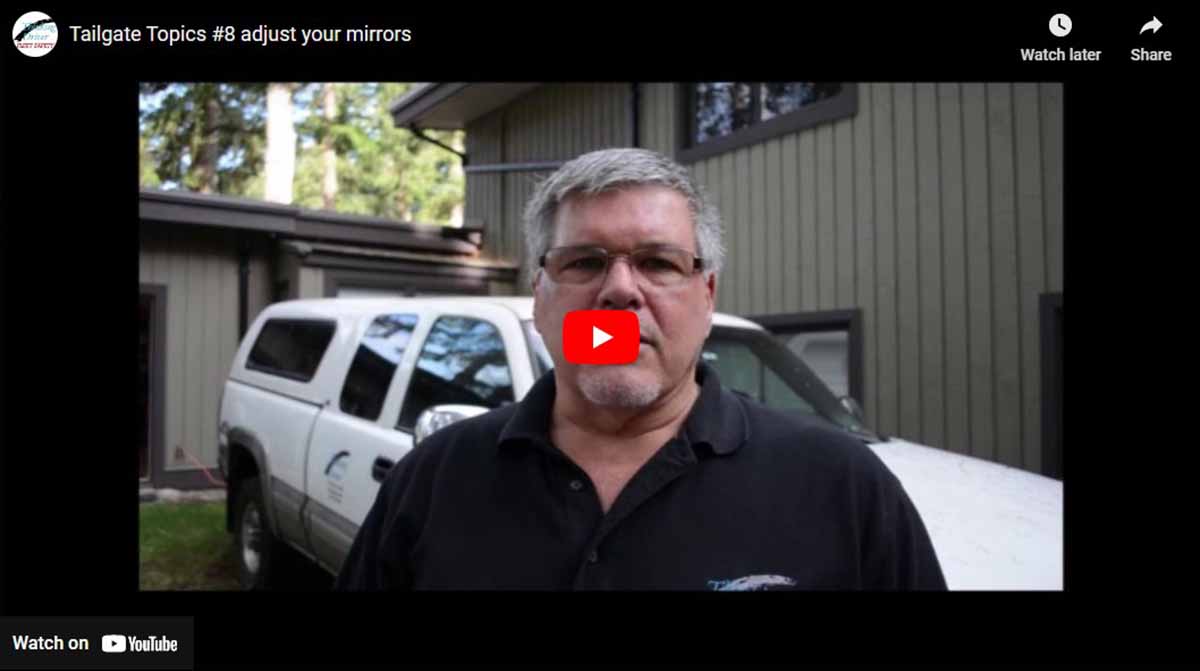Safety Meeting Planner & Agenda
Adjust Your Mirrors!
Meeting Leader:
- Prepare in advance to make this meeting effective.
- Print and read over this entire agenda.
- Think about how you want to lead the meeting.
- Is there anything that is specific to your company or operation that you can include to personalize the information?
- Review the video for this session.
- Save the link to the video in your ‘Favourites’ folder on your browser for easy access.
- Open and then minimize the viewer just before the meeting to make the video introduction smooth.
Start Your Meeting!
Opening Statement:
Awareness of everything around you when you are driving is critical to safety. Using your eyes effectively to look well ahead is important but mirror use is also critical to stay aware of what’s going on to the rear. Becoming aware of everything around you is called ‘situational awareness’. This is a term first used to describe a fighter plane pilot’s ability to be aware of everything that is going on around him in 3 dimensions. We are equally concerned with the space around us and not only what’s going on in front.
The Questions for this Meeting:
Q: Why is it important to be aware of what’s going on behind you?
Answers:
- Knowing how close the driver behind is following will have an effect on your braking and following distance from the car in front.
- Vehicles to the rear in other lanes may be preparing to pass or be in the way if you are changing lanes.
One of the challenges of being fully aware of what’s going on to the rear is the blind spot problem.
Q: What are blind spots and where are they located on most vehicles?
Answers:
- Blind spots are the areas around the vehicle that you cannot see directly using your eyes or by use of the mirrors.
- The most common ones are to the rear and side in the lanes on either side.
- Larger vehicles without rear windows also have large blind spots directly to the rear.
- There may be blind spots to the front that are created by the pillars that frame the windshield and support the roof.
One way to reduce blind spots to the rear is to correctly adjust your mirrors. Many drivers adjust the side or ‘wing’ mirrors so that they see mostly what is behind them and much of the mirror view is taken up with view of the side of the vehicle. We don’t need to see the side of the vehicle that we are driving. We need to see what’s going on in the blind spots.
Tailgate Tips:
Here is how to properly adjust your mirrors to reduce blind spots:
- Sit in your normal driving position.
- Turn your head to look in the mirror that you are adjusting; you should just barely see (or not quite see without tilting your head) the side of the vehicle.
- If you see more than this, move the mirror out until this is the view that you have.
- Now do the other side the same way.
- Your mirrors are now properly adjusted to minimize the blind spots.
- Next, if you have an inside rear view mirror, adjust it to look directly back out the rear window.
Correctly adjusted mirrors will allow you to track vehicles now as you drive. Vehicles directly behind you can be seen in the rear view and as they move to the side into the next lane, you should be able to track this movement and see them in the side mirror as they move into what is often the blind spot in vehicles with incorrectly adjusted mirrors. As the vehicle moves past, you should see them in the side mirror and in your peripheral vision at the same time so they are never out of your awareness.
Introduce the Video:
Spencer McDonald discusses the importance of adjusting your vehicle mirrors.
Practical Challenge:
- Take everyone out and check the mirror adjustment on vehicles in the parking lot or yard.
- Pay attention to the enhanced view that correct mirror adjustment provides.









